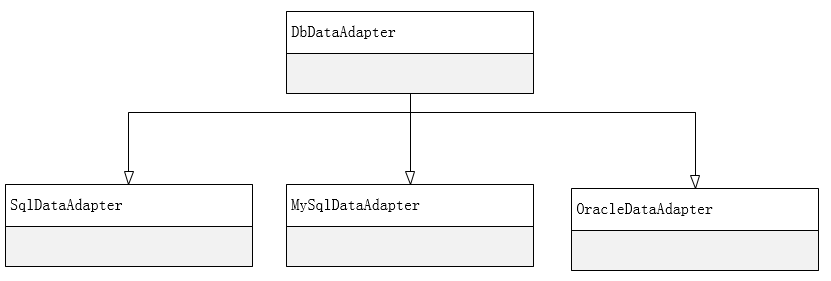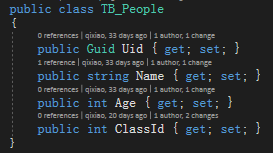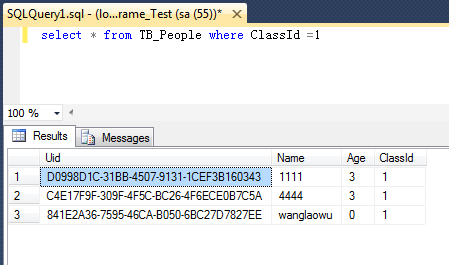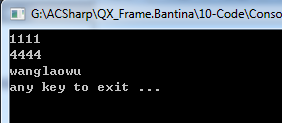C#操作SqlServer MySql Oracle通用幫助類
C#操作SqlServer MySql Oracle通用幫助類
【前言】
作為一款成熟的面向對象高級編程語言,C#在ADO.Net的支持上已然是做的很成熟,我們可以方便地調用ADO.Net操作各類關系型數據庫,在使用了多年的Sql_Helper_DG後,由於項目需要,於是乎,就準備寫一個Mysql_Helper在實現過程中,發現ADO.Net封裝之完善,以及面向對象的封裝、繼承、多態,有了這些特性,何不把數據庫操作封裝成為一個通用的類呢,此文由此鋪展而來...
【實現功能】
這篇文章將要介紹的主要內容如下:
1、ADO.NET之SqlServer
2、ADO.NET之Oracle
3、ADO.NET之MySql
4、充分利用面向對象的特征,實現通用的操作類
【環境準備】
1、MySql連接器的DLL引用
使用Nuget搜索 MySql.Data 引用即可:

2、Oracle連接器的DLL引用
使用Nuget搜索 Oracle.ManagedDataAccess 進行引用:

【實現思路】
在ADO.NET對SqlServer,Oracle,Mysql的操作熟練的基礎上,我們逐漸發現所有的操作都是使用的同一套的東西,不同的是:
SqlServer的操作使用的是SqlConnection、SqlCommand,SqlDataAdapter;
MySql使用的是MySqlConnection、MySqlCommand、MySqlDataAdapter;
Oracle使用的是OracleSqlConnection、OracleCommand、OracleDataAdapter;
該連接類,操作類都分別繼承自基礎類:DbConnection、DbCommand、DbDataAdapter;
其類間關系如圖所示:
1.DbConnection家族

2.DbCommand家族

3.DBDataAdapter家族

了解如上的幾個特點後,我們裏面能聯系到了“多態”這個概念,我們可以使用同一套相同的代碼,用“多態”的特性實例化出不同的實例,進而可以進一步封裝我們的操作,達到代碼精煉可重用的目的。
【實現過程】
1.定義枚舉類 Opt_DataBaseType 用於參數選擇具體要實例的數據庫
1 public enum Opt_DataBaseType
2 {
3 SqlServer,
4 MySql,
5 Oracle
6 }
2.自定義內部類SqlConnection_WR_Safe(多態提供DbConnection的對象、讀寫分離的支持)
1.在該內部類中,我們定義類屬性DbConnection用於承接根據不同的數據庫參數多態實例化後的對應Connection
2.實現IDisposable接口,提供釋放DbConnection的方法
3.在讀數據庫連接失敗時,及時切換到讀寫主數據庫,提升系統的可用性

1 internal class SqlConnection_WR_Safe : IDisposable
2 {
3 /// <summary>
4 /// SqlConnection
5 /// </summary>
6 public DbConnection DbConnection { get; set; }
7
8 public SqlConnection_WR_Safe(Opt_DataBaseType dataBaseType, string ConnString_RW)
9 {
10 this.DbConnection = GetDbConnection(dataBaseType, ConnString_RW);
11 }
12 /**
13 * if read db disabled,switchover to read write db immediately
14 * */
15 public SqlConnection_WR_Safe(Opt_DataBaseType dataBaseType, string ConnString_R, string ConnString_RW)
16 {
17 try
18 {
19 this.DbConnection = GetDbConnection(dataBaseType, ConnString_R);
20 }
21 catch (Exception)
22 {
23 this.DbConnection = GetDbConnection(dataBaseType, ConnString_RW);
24 }
25 }
26
27 /// <summary>
28 /// GetDataBase ConnectionString by database type and connection string -- private use
29 /// </summary>
30 /// <param name="dataBaseType"></param>
31 /// <param name="ConnString"></param>
32 /// <returns></returns>
33 private DbConnection GetDbConnection(Opt_DataBaseType dataBaseType, string ConnString)
34 {
35 switch (dataBaseType)
36 {
37 case Opt_DataBaseType.SqlServer:
38 return new SqlConnection(ConnString);
39 case Opt_DataBaseType.MySql:
40 return new MySqlConnection(ConnString);
41 case Opt_DataBaseType.Oracle:
42 return new OracleConnection(ConnString);
43 default:
44 return new SqlConnection(ConnString);
45 }
46 }
47 /// <summary>
48 /// Must Close Connection after use
49 /// </summary>
50 public void Dispose()
51 {
52 if (this.DbConnection != null)
53 {
54 this.DbConnection.Dispose();
55 }
56 }
57 }

3.自定義內部類 DbCommandCommon 用於提供DbCommand對象

1 internal class DbCommandCommon : IDisposable
2 {
3 /// <summary>
4 /// common dbcommand
5 /// </summary>
6 public DbCommand DbCommand { get; set; }
7 public DbCommandCommon(Opt_DataBaseType dataBaseType)
8 {
9 this.DbCommand = GetDbCommand(dataBaseType);
10 }
11
12 /// <summary>
13 /// Get DbCommand select database type
14 /// </summary>
15 /// <param name="dataBaseType"></param>
16 /// <returns></returns>
17 private DbCommand GetDbCommand(Opt_DataBaseType dataBaseType)
18 {
19 switch (dataBaseType)
20 {
21 case Opt_DataBaseType.SqlServer:
22 return new SqlCommand();
23 case Opt_DataBaseType.MySql:
24 return new MySqlCommand();
25 case Opt_DataBaseType.Oracle:
26 return new OracleCommand();
27 default:
28 return new SqlCommand();
29 }
30 }
31 /// <summary>
32 /// must dispose after use
33 /// </summary>
34 public void Dispose()
35 {
36 if (this.DbCommand != null)
37 {
38 this.DbCommand.Dispose();
39 }
40 }
41 }

4.自定義內部類 DbDataAdapterCommon 用於提供DbDataAdapter
該類繼承自DbDataAdapter,以實現DataAdapter的Fill方法,可以將結果集填充到DataSet中去。

1 /// <summary>
2 /// DbDataAdapterCommon
3 /// </summary>
4 internal class DbDataAdapterCommon : DbDataAdapter, IDisposable
5 {
6 public DbDataAdapter DbDataAdapter { get; set; }
7 public DbDataAdapterCommon(Opt_DataBaseType dataBaseType, DbCommand dbCommand)
8 {
9 //get dbAdapter
10 this.DbDataAdapter = GetDbAdapter(dataBaseType, dbCommand);
11 //provid select command
12 this.SelectCommand = dbCommand;
13 }
14 private DbDataAdapter GetDbAdapter(Opt_DataBaseType dataBaseType, DbCommand dbCommand)
15 {
16 switch (dataBaseType)
17 {
18 case Opt_DataBaseType.SqlServer:
19 return new SqlDataAdapter();
20 case Opt_DataBaseType.MySql:
21 return new MySqlDataAdapter();
22 case Opt_DataBaseType.Oracle:
23 return new OracleDataAdapter();
24 default:
25 return new SqlDataAdapter();
26 }
27 }
28 /// <summary>
29 /// must dispose after use
30 /// </summary>
31 public new void Dispose()
32 {
33 if (this.DbDataAdapter != null)
34 {
35 this.DbDataAdapter.Dispose();
36 }
37 }
38 }

5.在執行Sql查詢的時候,我們便使用我們自定義的內部類進行操作
>1 這裏以ExecuteNonQuery為例:


1 public static int ExecuteNonQuery(string commandTextOrSpName, CommandType commandType = CommandType.Text)
2 {
3 using (SqlConnection_WR_Safe conn = new SqlConnection_WR_Safe(dataBaseType, ConnString_RW))
4 {
5 using (DbCommandCommon cmd = new DbCommandCommon(dataBaseType))
6 {
7 PreparCommand(conn.DbConnection, cmd.DbCommand, commandTextOrSpName, commandType);
8 return cmd.DbCommand.ExecuteNonQuery();
9 }
10 }
11 }

該代碼通過參數DataBaseType確定要實例化的數據庫類型,ConnString_RW傳入寫數據庫的連接字符串進行實例化,DbCommand也是使用dataBaseType實例我們需要實際操作的數據庫對象。
>2 查詢ExecuteDataSet方法:

該方法通過參數dataBaseType確定要實例化的具體DbConnection,通過讀寫分離的連接字符串進行選擇讀庫和寫庫。

1 public static DataSet ExecuteDataSet(string commandTextOrSpName, CommandType commandType = CommandType.Text)
2 {
3 using (SqlConnection_WR_Safe conn = new SqlConnection_WR_Safe(dataBaseType, ConnString_R, ConnString_RW))
4 {
5 using (DbCommandCommon cmd = new DbCommandCommon(dataBaseType))
6 {
7 PreparCommand(conn.DbConnection, cmd.DbCommand, commandTextOrSpName, commandType);
8 using (DbDataAdapterCommon da = new DbDataAdapterCommon(dataBaseType, cmd.DbCommand))
9 {
10 DataSet ds = new DataSet();
11 da.Fill(ds);
12 return ds;
13 }
14 }
15 }
16 }

全部代碼見此:
1、數據庫選擇器枚舉類:Opt_DataBaseType->
 View Code
View Code
2、主類代碼Db_Helper_DG->
 Db_Helper_DG
Db_Helper_DG
Db_Helper_DG簡介:
本類分為 ExecuteNonQuery、ExecuteScalar、ExecuteScalar、ExecuteDataTable、ExecuteDataSet、ExecuteList Entity、ExecuteEntity七大部分,每一部分分為 無條件參數執行Sql語句或存儲過程、SqlParameter[]參數執行Sql語句,Object[]參數執行存儲過程三個重載方法。
方法的詳細代碼見上一條主代碼Db_Helper_DG中折疊部分,這裏對ExecuteListEntity和ExecuteEntity方法進行著重介紹。
ExecuteListEntity和ExecuteEntity,此二方法是為了將查詢結果和Model即Entity實體進行映射所用,使用C#反射Reflect技術,進行將查詢結果直接賦值成為了Entity或者List<Entity>對象(此亦是ORM框架的核心)
ExecuteList方法通過二次封裝,顯式調用GetListFromDataSet方法,從DataSet結果集中遍歷結果以進行賦值,代碼如下:

1 public static List<Entity> GetListFromDataSet<Entity>(DataSet ds) where Entity : class
2 {
3 List<Entity> list = new List<Entity>();//實例化一個list對象
4 PropertyInfo[] propertyInfos = typeof(Entity).GetProperties(); //獲取T對象的所有公共屬性
5
6 DataTable dt = ds.Tables[0]; // 獲取到ds的dt
7 if (dt.Rows.Count > 0)
8 {
9 //判斷讀取的行是否>0 即數據庫數據已被讀取
10 foreach (DataRow row in dt.Rows)
11 {
12 Entity model1 = System.Activator.CreateInstance<Entity>();//實例化一個對象,便於往list裏填充數據
13 foreach (PropertyInfo propertyInfo in propertyInfos)
14 {
15 try
16 {
17 //遍歷模型裏所有的字段
18 if (row[propertyInfo.Name] != System.DBNull.Value)
19 {
20 //判斷值是否為空,如果空賦值為null見else
21 if (propertyInfo.PropertyType.IsGenericType && propertyInfo.PropertyType.GetGenericTypeDefinition().Equals(typeof(Nullable<>)))
22 {
23 //如果convertsionType為nullable類,聲明一個NullableConverter類,該類提供從Nullable類到基礎基元類型的轉換
24 NullableConverter nullableConverter = new NullableConverter(propertyInfo.PropertyType);
25 //將convertsionType轉換為nullable對的基礎基元類型
26 propertyInfo.SetValue(model1, Convert.ChangeType(row[propertyInfo.Name], nullableConverter.UnderlyingType), null);
27 }
28 else
29 {
30 propertyInfo.SetValue(model1, Convert.ChangeType(row[propertyInfo.Name], propertyInfo.PropertyType), null);
31 }
32 }
33 else
34 {
35 propertyInfo.SetValue(model1, null, null);//如果數據庫的值為空,則賦值為null
36 }
37 }
38 catch (Exception)
39 {
40 propertyInfo.SetValue(model1, null, null);//如果數據庫的值為空,則賦值為null
41 }
42 }
43 list.Add(model1);//將對象填充到list中
44 }
45 }
46 return list;
47 }

ExecuteEntity部分又分為從DataReader中獲取和Linq從List<Entity>獲取第一條進行獲取兩種方式,由於DataReader有占用連接不釋放的特點,在高並發的環境下使用並不友好,因此在實際生產環境中使用推薦使用第二種Linq獲取List<Entity>的方式:

1 public static Entity GetEntityFromDataReader<Entity>(DbDataReader reader) where Entity : class
2 {
3 Entity model = System.Activator.CreateInstance<Entity>(); //實例化一個T類型對象
4 PropertyInfo[] propertyInfos = model.GetType().GetProperties(); //獲取T對象的所有公共屬性
5 using (reader)
6 {
7 if (reader.Read())
8 {
9 foreach (PropertyInfo propertyInfo in propertyInfos)
10 {
11 //遍歷模型裏所有的字段
12 if (reader[propertyInfo.Name] != System.DBNull.Value)
13 {
14 //判斷值是否為空,如果空賦值為null見else
15 if (propertyInfo.PropertyType.IsGenericType && propertyInfo.PropertyType.GetGenericTypeDefinition().Equals(typeof(Nullable<>)))
16 {
17 //如果convertsionType為nullable類,聲明一個NullableConverter類,該類提供從Nullable類到基礎基元類型的轉換
18 NullableConverter nullableConverter = new NullableConverter(propertyInfo.PropertyType);
19 //將convertsionType轉換為nullable對的基礎基元類型
20 propertyInfo.SetValue(model, Convert.ChangeType(reader[propertyInfo.Name], nullableConverter.UnderlyingType), null);
21 }
22 else
23 {
24 propertyInfo.SetValue(model, Convert.ChangeType(reader[propertyInfo.Name], propertyInfo.PropertyType), null);
25 }
26 }
27 else
28 {
29 propertyInfo.SetValue(model, null, null);//如果數據庫的值為空,則賦值為null
30 }
31 }
32 return model;//返回T類型的賦值後的對象 model
33 }
34 }
35 return default(Entity);//返回引用類型和值類型的默認值0或null
36 }

1 public static Entity GetEntityFromDataSet<Entity>(DataSet ds) where Entity : class
2 {
3 return GetListFromDataSet<Entity>(ds).FirstOrDefault();
4 }
【系統測試】
在全部功能實現之余,下面我們進行代碼測試環節。
1、MySql數據庫操作

各種方式給Db_Helper_DG的鏈接字符串屬性進行賦值,這裏不再贅述。


根據測試表的設計進行新建對應的實體類:

1 public class TB_People
2 {
3 public Guid Uid { get; set; }
4 public string Name { get; set; }
5 public int Age { get; set; }
6 public int ClassId { get; set; }
7 }


填寫好連接字符串,並給Db_Helper_DG類的ConnString_Default屬性賦值後,我們直接調用方法進行查詢操作。

調用靜態方法ExecuteList以便直接映射到實體類:
1 List<TB_People> peopleList = Db_Helper_DG.ExecuteList<TB_People>("select * from student where ClassId=?ClassId", System.Data.CommandType.Text, new MySqlParameter("?ClassId", 1));
2 foreach (var item in peopleList)
3 {
4 Console.WriteLine(item.Name);
5 }

這裏的MySql語句 select * from student where ClassId=?ClassId 然後參數化賦值 ?ClassId=1 進行查詢。
結果如下:

可見,查詢結果並無任何差池,自動映射到了實體類的屬性。
2、SqlServer數據庫操作

因為數據庫結構MySql和SqlServer的結構是一致的,因此使用上述的實體類TB_People。

同樣填寫連接字符串,並給Db_Helper_DG類的ConnString_Default屬性賦值後,我們直接調用方法進行查詢操作。
![]()

然後我們修改Sql語句,並且修改為SqlServer傳遞參數方式進行查詢:

1 List<TB_People> peopleList = Db_Helper_DG.ExecuteList<TB_People>("select * from TB_People where [email protected]", System.Data.CommandType.Text, new SqlParameter("@ClassId", 1));
2 foreach (var item in peopleList)
3 {
4 Console.WriteLine(item.Name);
5 }
select * from TB_People where ClassId =1,ClassId按照SqlServer參數傳遞的方式進行傳遞。

可見,查詢結果並無任何差池,自動映射到了實體類的屬性。
3、Oracle由於本人當前Oracle環境問題,先不進行測試。
C#操作SqlServer MySql Oracle通用幫助類
